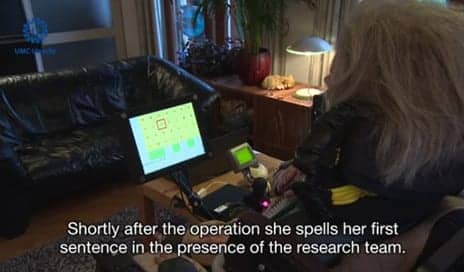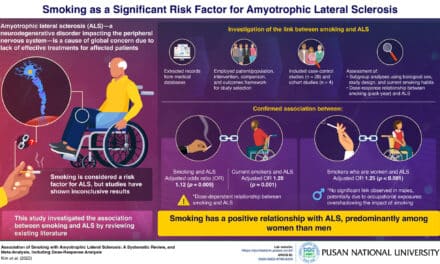
Pictured here is a screen capture from a YouTube video (https://www.youtube.com/watch?v=H1_4br0CFI8) documenting the patient spelling her first sentence in the presence of the research team. (Photo courtesy of UMC Utrecht)
An implant recently placed in the brain of an amyotrophic lateral sclerosis (ALS) patient who is no longer able to move or speak now enables her to operate a speech computer with her mind.
A study published in New England Journal of Medicine describes the procedure and its results.
“This is a major breakthrough in achieving autonomous communication among severely paralyzed patients whose paralysis is caused by either ALS, a cerebral hemorrhage or trauma,” says Professor Nick Ramsey, professor of cognitive neuroscience at the University Medical Center (UMC) Utrecht, in a media release from UMC Utrecht, where the procedure was performed.
“In effect, this patient has had a kind of remote control placed in her head, which enables her to operate a speech computer without the use of her muscles,” he adds.
The release explains that, during the procedure, electrodes were placed in her brain through tiny holes in her skull. A small transmitter was then placed in her body below her collarbone. This transmitter receives the signals from the electrodes via subcutaneous wires, amplifies them and transmits them wirelessly. The mouse click is calculated from these signals, actuating the speech computer.
The patient operates the speech computer by moving her fingers in her mind. This changes the brain signal under the electrodes. That change is converted into a mouse click. On a screen in front of her she can see the alphabet, plus some additional functions such as deleting a letter or word and selecting words based on the letters she has already spelled. The letters on the screen light up one by one. She selects a letter by influencing the mouse click at the right moment with her brain. That way she can compose words, letter by letter, which are then spoken by the speech computer, the release continues.
“We hope that these results will stimulate research into more advanced implants, so that some day not only people with communication problems, but also people with paraplegia, for example, can be helped,” Ramsey states.
[Source(s): UMC Utrecht, Science Daily]




